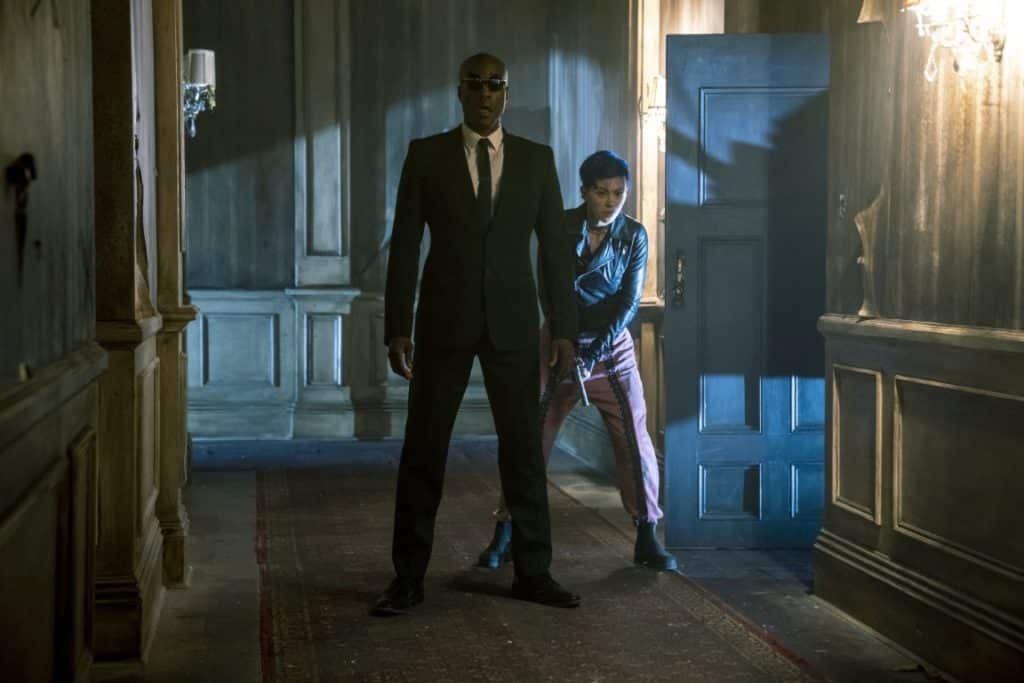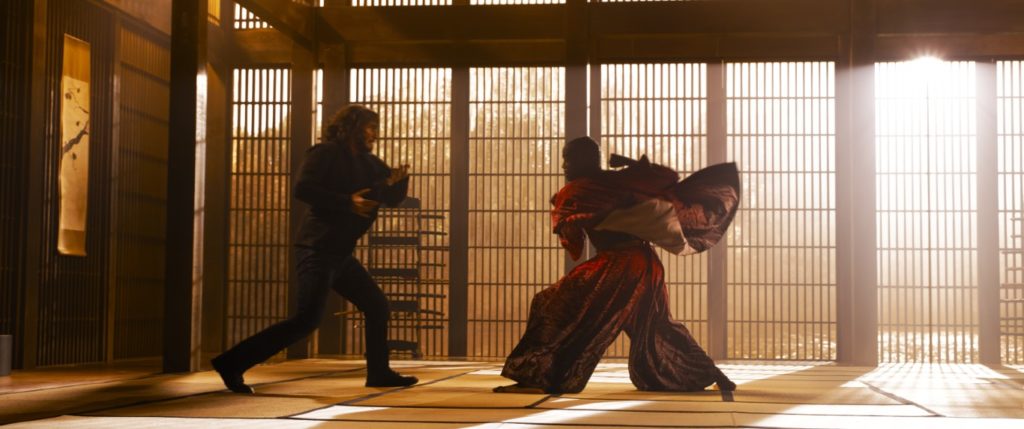Lana Wachowski’s return to the franchise is a messy, achingly sincere meta-sequel that refreshingly reflects on its very existence.
It’s hard to overstate just how seismic The Matrix was when it was first released in 1999. Looking back on it now, in an age of focus-tested corporate franchises, extended universes, and an even more top-heavy IP landscape than we had back then, it feels positively revolutionary. Even in its imperfect but-radically-reappraised 2003 sequels, Reloaded and Revolutions, filmmakers Lana and Lilly Wachowski manage to build a world that’s at once evocative of so many of its influences (cyberpunk, bullet opera, kung fu film, Star Wars) but feels highly original. And what’s more, is unafraid to tackle challenging, often heady psychological questions while still revolutionizing the way action movies were made.
If anything, it’s a surprise it’s taken this long for the corporate overlords at Warner Bros. to get around to making a “legacyquel” of sorts to one of their most iconic properties: those cynical things that, with few exceptions, feel like mere shadows and callbacks to the series they’re ‘reviving’. How lucky for us, then, that The Matrix Resurrections knows the nostalgia trap it’s falling into, and turns it into one of the film’s biggest strengths instead. The result is a film that’s achingly aware of its innate nature as a franchise obligation, and taking big, messy chances with it anyways.
“We know this story,” murmurs Bugs (Jessica Henwick, easily carrying the non-Neo parts of the film), a member of the human resistance in the opening minutes, as she — and we — witness a not-quite-perfect reenactment of Trinity’s escape from the Agents at the beginning of the first Matrix. It’s a refrain we’ll hear in one form or another throughout Resurrections, as callback after callback to the first few films comes sliding on the screen like so much green code. Returning without sister Lilly, Lana Wachowski (who also co-writes the script alongside novelists David Mitchell and Aleksander Hemon) isn’t content to just give us another chapter in the war against the machines: she wants to examine why we want to go back in the first place.

Which is where Neo, or, well, Thomas Anderson (Keanu Reeves) comes in. By his perception, he’s an acclaimed video game programmer who’s earned boatloads of fame and money for making a series of popular games called — you guessed it — The Matrix. But something’s missing from his life: he’s depressed, listless, under the care of a patronizing therapist (Neil Patrick Harris) who keeps him medicated (ostensibly to prevent him from another attempt at suicide). The only glimmers of joy he gets are when he flirts with a married woman named Tiffany (Carrie-Anne Moss) at the coffee shop every morning. What’s more, his business partner (Jonathan Groff) gives him a mandate from their parent company Warner Bros. (natch): they have to make a Matrix sequel.
Where this mandate takes Thomas, whether he “wakes up” to the real world or realizes the Matrix was just an escape from his own terribly mundane life, we’ll leave up to the viewers to decide when they see it. But one thing’s for sure: The Matrix Resurrections is made by the same Lana Wachowski whose late output has pulled even harder on the lever of “silly, sincere, humanist spectacle”. Much like later works like Sense8 and Cloud Atlas (which Mitchell also helped adapt from his own novel), Resurrections wears its heart on its white-rabbit-tattooed sleeve; it’s unabashedly sentimental about its world and characters, taking big, giant, unsubtle swings that might rankle folks looking for a bit more subtlety. (Though if you are, what the hell are you doing watching a Wachowski movie?)
Blissfully, while the production design maintains that industrial, chrome-and-red look from the original films, Resurrections updates its style in several important ways. For one thing, cinematographer John Toll (alongside Daniele Massaccessi) replaces the sickly-green sheen of the previous films with a sun-dappled flash of color, especially in the cityscapes of the Matrix itself. Costume designer Lindsay Pugh dresses her characters in grounded, practical outfits that suggest the leather and trenchchoat look of Kym Barrett’s original costumes while updating them with a slick new fit. (Yahya Abdul-Mateen II‘s character, who suggests Morpheus but isn’t quite for several in-universe reasons, gets some especially bold digs.)

The supporting cast is having a blast, from Henwick’s star-making heroism to Groff and NPH’s deliciously slimy turns. (Sense8 fans will clap their hands at each new cameo from one of the show’s expansive main cast; Lana clearly loves working with them, and threw them in here as a little treat.) Some characters are original; others are older, or even rebooted, versions of folks we already know. New characters hero-worship Neo in ways that likely mirror their actor’s hero-worship of Keanu and the Wachowskis; wheels within wheels, endlessly repeating loops of memory and nostalgia.
But at the core of all of Lana’s self-reflexive pontificating about the nature of IP filmmaking, and the innate cynicism of doing a Matrix sequel twenty-odd years later, Resurrections is a love story between two people (Neo and Trinity) torn apart by forces who need them to be close, but not actually together; how innate to the longing of queerness is that? Their awakening, both to their real selves and their powers, is the beating heart that grounds all the slickly-rendered CG action. Both Reeves and Moss wear their years with incredible grace, the former with a world-weary zen, the latter with steely resolve. And when they’re in a room together, you remember why people loved them in the first place. Resurrection‘s story — and the fate of humanity — rests on these two lost kids finding each other again. It’s that unabashed romanticism that holds together so much of its brittle framework.
Fittingly with any Wachowski project, it doesn’t all work: The script is as ambitious as it is messy, and Toll’s handheld work in the action scenes admittedly robs us of the series’ revolutionary kung-fu mastery. (Yuen Woo-Ping did not return to choreograph the fights, and you can really tell.) In lieu of wide masters of fast-flying fists, Resurrection‘s action is much more of the gunplay/superpowered variety, and their scope — likely limited by the restrictions of filming during COVID, especially in the climax — suffers as a result. I’ll probably have to watch it a million more times to figure out how footage from the Matrix “game” just looks like scenes from the movie; are we saying the film was one of those full-motion-video affairs from the mid-90s?

But even the mess feels singular, the product of an actual auteur driving the vision of a work that feels personal, even in its checklist-filling obligations. Just as Tom bristles against the idea of going “back to the Matrix,” as Groff’s character excitedly tells him, so too does Lana, now older and a much different person than she was when she made the first film, wonder where it fits in her life. But she found a reason to go back and have it matter, the underlying sentiment that buoys so many of her achingly sincere works: Love. Wachowski expands the series’ already-dense lore with some fun extrapolations, from a new version of Zion to living machines that side with humanity.
In so many ways, The Matrix Resurrections is a film about its own making — where its creators are at this stage in their lives, the stifling, choking grip of IP-based filmmaking, attempting to understand just what made the series so appealing in the first place. That Wachowski could take this remit, flip it on its head, and make something endearingly messy, human, and intimately new with it, is nothing short of a miracle. Resurrections feels as much like “the new Wachowski film” (or, dare I say, a hidden sequel to Sense8‘s earnest humanism) as it does a brand-mandated IP upgrade. It’ll either piss you off or make you punch the air, sometimes in the same scene. But in a world where nothing comes to (or succeeds in) theaters without being attached to an existing property or having four-quadrant appeal, it’s fitting that the blockbuster that queered blockbusters has done it again.
The Matrix Resurrections teaches you kung fu all over again in theaters and on HBO Max December 22nd.
The Matrix Resurrections Trailer:
Read next: The Spool's Best New Releases
Streaming guides
The Best Live TV Streaming Services With Free Trial
The praises of live TV streaming services don’t need to be further sung. By now, we all know that compared to clunky, commitment-heavy cable, live TV is cheaper and much easier to manage. But just in case you’re still on the fence about jumping over to the other side, or if you’re just unhappy with ... The Best Live TV Streaming Services With Free Trial
How to Watch Power Book III: Raising Kanan Season 3
Season 3 of the hotly anticipated Power spin-off, Power Book III: Raising Kanan, is arriving on Starz soon, so you know what that means: it’s the ’90s again in The Southside, and we’re back with the Thomas family as they navigate the ins and outs of the criminal underworld they’re helping build. Mekai Curtis is ... How to Watch Power Book III: Raising Kanan Season 3
How to Watch Doctor Who: 60th Anniversary Specials
Ladies and gentlemen, we’re so back! To celebrate Doctor Who’s 60th anniversary, the BBC is producing a three-episode special starring none other than the Tenth/Fourteenth Doctor himself, David Tennant. And to the supreme delight of fans (that would be me, dear reader), the Doctor will be joined by old-time companion Donna Noble (Catherine Tate) and ... How to Watch Doctor Who: 60th Anniversary Specials
Which Netflix Country has Interstellar?
Maybe you’ve just seen Oppenheimer and have the strongest urge to marathon—or more fun yet, rank!—all of Christopher Nolan’s films. Or maybe you’re one of the few who haven’t seen Interstellar yet. If you are, then you should change that immediately; the dystopian epic is one of Nolan’s best, and with that incredible twist in ... Which Netflix Country has Interstellar?
Which Netflix Country Has Each Movie of The Hunger Games?
For whatever reason, The Hunger Games series isn’t available in the same countries around the world. You’ll find the first and second (aka the best) installments in Hong Kong, for instance, but not the third and fourth. It’s a frustrating dilemma, especially if you don’t even have a single entry in your region, which is ... Which Netflix Country Has Each Movie of The Hunger Games?
How to Watch ESPN With A Free Trial
One of the major concerns people have before cutting the cord is potentially losing access to live sports. But the great thing about live TV streaming services is that you never lose that access. Minus the contracts and complications of cable, these streaming services connect you to a host of live channels, including ESPN. So ... How to Watch ESPN With A Free Trial
How to Watch Paramount Network With a Free Trial
To date, Paramount Network has only two original shows on air right now: Yellowstone and Bar Rescue. The network seems to have its hands full with on-demand streaming service Paramount+, which is constantly stacked with a fresh supply of new shows. But Yellowstone and Bar Rescue are so sturdy and expansive that the network doesn’t ... How to Watch Paramount Network With a Free Trial
How to Watch WE TV With a Free Trial
Previously “Women’s Entertainment,” We TV has since rebranded to accurately reflect its name and be a more inclusive lifestyle channel. It’s home to addictive reality gems like Bold and Bougie, Bridezillas, Marriage Boot Camp, and The Untold Stories of Hip Hop. And when it’s not airing original titles, it has on syndicated shows like 9-1-1, ... How to Watch WE TV With a Free Trial
How to Watch Comedy Central With a Free Trial
It’s no coincidence that many of today’s biggest comedians found their footing on Comedy Central: the channel is a bastion of emerging comic talents. It served as a playground for people like Nathan Fielder (Fielder For You), Ilana Glazer and Abbi Jacobson (Broad City), Tim Robinson (Detroiters), and Dave Chappelle (Chappelle’s Show) before they shot ... How to Watch Comedy Central With a Free Trial
How to Watch FX With a Free Trial
You’d be hard-pressed to find a bad show airing on FX. The channel has made a name for itself as a bastion of high-brow TV, along with HBO and AMC. It’s produced shows like Atlanta, Fargo, The Americans, Archer, and more recently, Shogun. But because it’s owned by Disney, it still airs several blockbusters in ... How to Watch FX With a Free Trial
How to Watch TNT Sports With A Free Trial
For many sports fans, TNT is a non-negotiable. It broadcasts NBA, MLB, NHL, college basketball, and All Elite Wrestling matches. And, as a bonus, it also has reruns of shows like Supernatural, Charmed, and NCIS, as well as films like The Avengers, Dune, and Justice League. But while TNT used to be a cable staple, ... How to Watch TNT Sports With A Free Trial